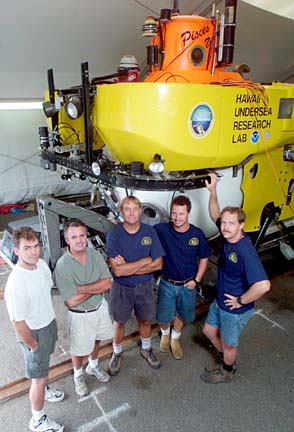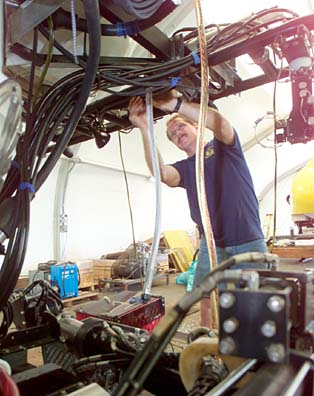
DEAN SENSUI / DSENSUI@STARBULLETIN.COM
Standing in front of the research submersible Pisces V are Colin Wolleman, left, Chuck Holloway, Terry Kerby, Max Cremer and Steve Price. The Pisces V and Pisces IV are being prepared for a series of dives in the northwestern Hawaiian islands and at Loihi off the Big Island.
UH researchers who found
a mini- sub will dive around
the northwest islands
The Hawaii Undersea Research Laboratory's two submersibles are preparing for a $1.2 million, 60-day expedition to investigate fisheries and coral reserves in the northwestern Hawaiian islands.
The three-person submersibles, Pisces V and Pisces IV, also will survey the area around the Japanese midget submarine they discovered in Pearl Harbor a year ago and do research dives on seamount Loihi off the Big Island.
Pisces V recently revisited the midget submarine during two days of training operations, accompanied by a History Channel film crew and hosts of its Deep Sea Detectives Program, said Terry Kerby, HURL operations director and chief pilot.
COURTESY OF TERRY KERBY /HAWAII UNDERSEA RESEARCH LABORATORY
An underwater view of a Japanese midget submarine that was sunk off Pearl Harbor on the day of the attack.
COURTESY OF TERRY KERBY /HAWAII UNDERSEA RESEARCH LABORATORY
A U.S. Navy 180-foot patrol boat deliberately sunk off Oahu.
Pisces IV was to do test dives at the submarine site today, going from shallow to deeper water. "Basically, we're doing monitoring of the site," Kerby said. "The position is still pretty top secret."
COURTESY OF TERRY KERBY /HAWAII UNDERSEA RESEARCH LABORATORY
A photo of the Pisces IV investigating the 180-foot patrol boat.
He said Pisces V also surveyed a 180-foot patrol boat it found previously on the bottom west of the midget sub and got numbers off the side to track its history.
The submersible crew includes pilot Chuck Holloway and pilots-in-training Max Cremer, Colin Wollerman and Steve Price.
Their dive program this year is twice as long as any they've done previously without returning to port, said John Wiltshire, acting HURL director.
"We're using it as kind of ground-truthing for a larger expedition in late 2004 going down to American Samoa and on to New Zealand to look at islands and volcanoes there," he said.
"We're slowly developing capabilities to work more and more remotely."
The submersibles will do more pilot and safety training in deep-ocean dives southwest of Barbers Point before leaving Sept. 3 on their mother ship, Ka'imikai-O-Kanaloa, for the northwest islands.
Kerby said they'll make maximum depth dives to about 6,600 feet in an area a little further to the north, where a World War I class submarine F-28 was lost with all hands while doing exercises.
"It's an area we haven't looked at before. It's sort of like the midget sub that we kept an eye out for," he said.
In the northwestern islands, the HURL crew will rendezvous with Jean-Michel Cousteau's group and do 40 dives from Nihoa to Kure Island, Wiltshire said. The ship will go to Midway for research at the end of September and return here in November.
Besides the submersibles, researchers will use a remotely operated vehicle on the ship that has been upgraded to a fiber-optic system, Wiltshire said. It can operate down to 3,000 feet and will be used in the evenings to scope out the bottom for the dives, he said.
DEAN SENSUI / DSENSUI@STARBULLETIN.COM
Steve Price secured wiring on the exterior frame of the Pisces IV while working in a temporary shelter Friday at Snug Harbor.
Among key investigators will be UH oceanographer Craig Smith; Hawaii Pacific University oceanographer Eric Vetter; National Marine Fisheries Service fishery biologist Frank Parrish; Amy Baco-Taylor, a UH graduate now at Woods Hole Oceanographic Institution; and HURL researchers Chris Kelley and John Smith.
They will do some ocean mapping, mainly to support dives looking at the habitat, fisheries and coral, Wiltshire said. Robert Smith, who runs the northwestern Hawaiian islands refuge for NOAA, is sponsoring six dives, he said.
In early December, the submersibles will dive in Pele's Pit on Loihi with a Scripps Institution of Oceanography scientist. The Public Broadcasting System also is paying for dives to take a cameraman into the pit, Kerby said.
The submersibles will finish the dive season with a survey of the midget submarine area in mid-December with archaeologists from the National Park Service and National Oceanic and Atmospheric Administration's Sanctuaries Program.
"We hope at some point the midget site will become a NOAA marine sanctuary like the USS Monitor, the Civil War ironclad warship found off North Carolina," Wiltshire said.
HURL acquired Pisces V in 1987 and Pisces IV in 1999, which Kerby said was "a real coup," providing emergency capability and a backup operational system for the submersible program.
The first year Pisces IV was operational "she paid for herself," filling in for Pisces V after it was damaged in launch, he said.
Kerby said it was satisfying to have both submersibles on the ocean bottom when they found the Japanese submarine last August because it had been a long-term team effort to locate it.
The HURL divers were thrilled at the discovery because it was always such a mystery, and searches by the National Geographic and Titanic discoverer Robert Ballard of Woods Hole had missed it, Kerby said.
"So much is dumped there it's incredible that it survived 61 years. Fuel tanks and a ship are dumped there and old ordnance, and she's sitting there in a little protective spot in the center of all this stuff, unscathed," he said, adding his hope that it can become a protected reserve.
"In terms of modern marine archaeology, it's probably the most significant find after the Titanic," Wiltshire said.
He said the U.S. State Department is working with the Japanese Foreign Ministry to see what Japan's wishes are regarding the submarine.
Doug Lentz, USS Arizona Memorial superintendent, said NOAA and the National Park Service are working as partners to protect the submarine and to comply with Japanese wishes.
"It's part of the Pearl Harbor story, so from my perspective and the USS Arizona's perspective, it's something we have strong interest in and want to be part of our interpretive program."
The agencies are concerned about all the junk around the submarine and especially that "something is going to get dumped on it, unknowingly, and it will be damaged from the surface," Lentz said.
He said a survey is needed to help determine whether to protect only the submarine or a larger area because of the possibility of other historically significant artifacts.





